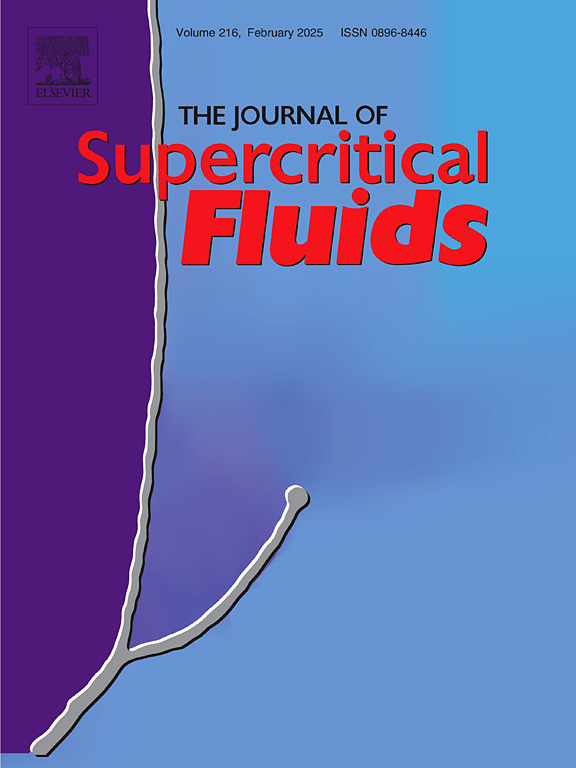乙醇对超临界CO2溶剂密度的影响
IF 3.4
3区 工程技术
Q2 CHEMISTRY, PHYSICAL
引用次数: 0
摘要
在制药、食品和化妆品领域的新工业应用中,超临界二氧化碳在提取非极性分子的过程中用作溶剂或抗溶剂。在单元操作过程中,通过增溶或沉淀,加入少量乙醇(EtOH)以分离极性分子。采用振动管密度计对纯二氧化碳(CO2)和质量成分分别为wCO2=0.99和wCO2=0.98的二氧化碳-乙醚二元混合物进行了密度测量。等温线是在高于临界温度的303、308和313 K的温度下测定的,压力范围为5到10 MPa。采用带有两个或三个参数的三次状态方程(Peng-Robinson和Coquelet-El Abbadi-Houriez方程)围绕临界点进行精细建模。采用Huron-Vidal混合规则与NRTL模型耦合。为了提高纯二氧化碳和二元CO2-EtOH混合物临界点附近的预测精度,采用了White的校正方法。对纯超临界二氧化碳的模拟结果显示,在临界点附近的误差为5.8%。本文章由计算机程序翻译,如有差异,请以英文原文为准。

Effect of ethanol on supercritical CO2 solvent densities
The development of new industrial applications in the pharmaceutical, food, and cosmetic fields uses supercritical carbon dioxide as a solvent or antisolvent in their processes for extracting non-polar molecules. Ethanol () is added in small quantities to isolate a polar molecule during a unit operation by solubilization or precipitation. Density measurements in pure carbon dioxide () and in binary - mixtures with mass compositions ( and ) were carried out using a vibrating tube densimeter. The isotherms were determined at temperatures of 303, 308, and 313 K, above the critical temperature, and for a pressure range from 5 to 10 MPa. Fine modeling around the critical point was performed using cubic equations of state with two or three parameters (Peng–Robinson and Coquelet–El Abbadi–Houriez EoS). The Huron-Vidal mixing rule coupled with the NRTL model was employed. To enhance the prediction around the critical point of pure carbon dioxide and binary - mixtures, White’s correction method was used. The results for pure supercritical carbon dioxide show modeling performance with a deviation of 5.8% around the critical point.
求助全文
通过发布文献求助,成功后即可免费获取论文全文。
去求助
来源期刊

Journal of Supercritical Fluids
工程技术-工程:化工
CiteScore
7.60
自引率
10.30%
发文量
236
审稿时长
56 days
期刊介绍:
The Journal of Supercritical Fluids is an international journal devoted to the fundamental and applied aspects of supercritical fluids and processes. Its aim is to provide a focused platform for academic and industrial researchers to report their findings and to have ready access to the advances in this rapidly growing field. Its coverage is multidisciplinary and includes both basic and applied topics.
Thermodynamics and phase equilibria, reaction kinetics and rate processes, thermal and transport properties, and all topics related to processing such as separations (extraction, fractionation, purification, chromatography) nucleation and impregnation are within the scope. Accounts of specific engineering applications such as those encountered in food, fuel, natural products, minerals, pharmaceuticals and polymer industries are included. Topics related to high pressure equipment design, analytical techniques, sensors, and process control methodologies are also within the scope of the journal.
 求助内容:
求助内容: 应助结果提醒方式:
应助结果提醒方式:


